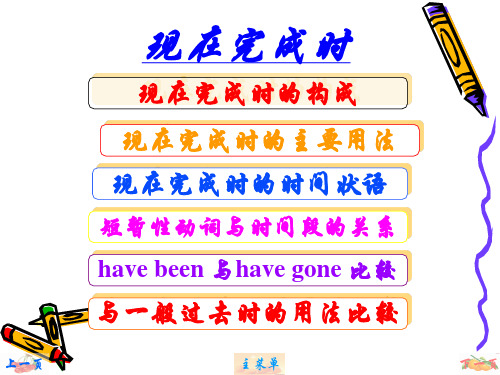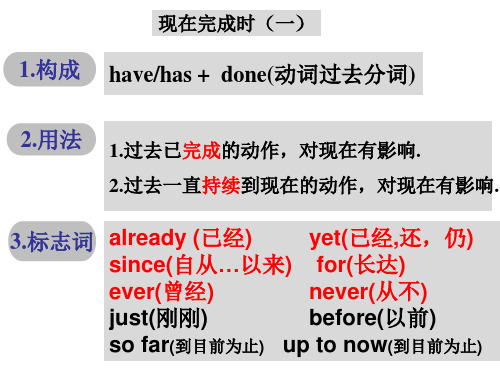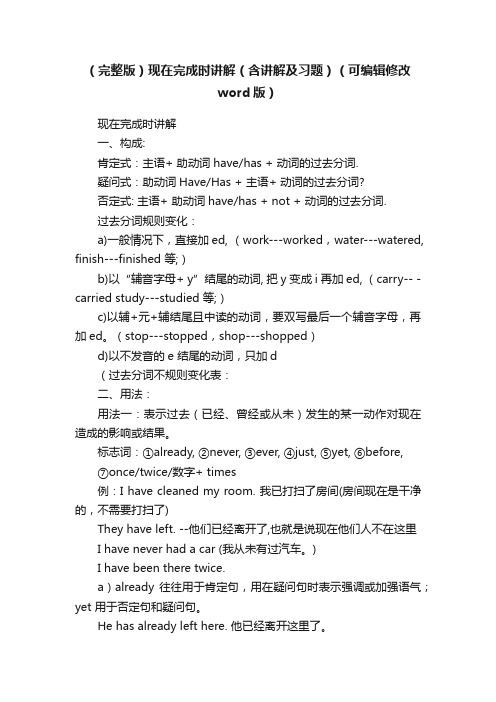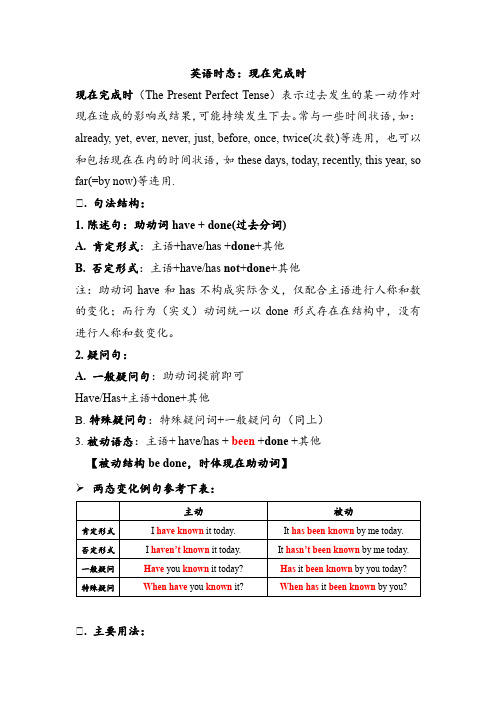英语现在完成时(完整)
(完整版)现在完成时讲解

I have had this watch for five years / since 5 years ago.
2.这位老人已经死了十年了。
WThe old man has died for ten years.
The old man has been dead for ten years/since 10 years ago.
I have learnt English for more than ten years.我已经学了10多年的英语。
(从10年前开始,持续到现在还在学)
上一页
She has swum since half an hour ago. 我已经游泳了半个小时
(半个小时前已经开始游泳,到现在还在游)
主菜单
于助动词或系动词后,实义动词前。 • never用于句中,助动词或系动词后,实
义动词前,表示否定意义。
• He has ever been to Paris.
• He has never been to Paris.
3) just表示“刚刚”(用于完成时态时,与already, never 等副词的位置一样,多用在助动词have/has和 动词过去分词之间)
He has been here for three days.
He has been here since yesterday.
He has been here since two days ago / last Monday.
He has been here since his wife died.
Since he was a child ,he has lived in England.
现在完成时(完整版)

2.转换成be+名词
join the army
join the Party go to school
be a soldier be a Party member be a student
3转换成be+形容词或副词 die leave close be dead finish be over begin
另外,还可用其它表示方法,但只适用于部 分瞬间动词。具体办法是将瞬间动词转化为表延 续的动词或者表状态的be+名词/形容词或副词/ 介词短语等。 1.直接转化成延续性动词 buy borrow have catch (get) a cold have a cold be
keep come/go /become
练习:用for 或since 填空
1. 2. 3. 4. ______ two years ______ two years ago ______ last month _______1999
5. It’s five years _______ we met last time.
6. We haven’t seen each other ____ a long time.
.
2. since+
(1) 过去的时间点 (2) 时间段+ago (3) 从句 (一般过去时)
Linda has studied Chinese since 2007.
Linda has studied Chinese since 5 years ago. Linda has studied Chinese since she was 4 years old.
I have kept the book since last week. I borrowed the book last week.
(完整版)现在完成时讲解及练习

(完整版)现在完成时讲解及练习Unit 9:现在完成时讲解一.基本结构:助动词have/has+过去分词(done)二.句型:否定句:主语+have/has+not+过去分词+其他.一般疑问句:Have/Has+主语+过去分词+其他.简略答语: Yes, 主语+ have/has.(肯定)No, 主语+ haven't/hasn't.(否定)三.用法(1)现在完成时表示过去发生或已经完成的动作对现在造成的影响或结果I have spent all of my money (so far).(含义是:现在我没有钱花了.)Guo zijun has (just/already) come. (含义:郭子君现在在这儿) My father has gone to work.(含义是:我爸爸现在不在这儿)(2)现在完成时可以用来表示发生在过去某一时刻的,持续到现在的动作(用行为动词表示)或状态(be动词表示)常与for(+时间段),since(+时间点或过去时的句子)连用.①for+时段②since+过去一个时间点(译为:自从……以来)③since+时段+ago④since+从句(过去时)●⑤It is+时段+since+从句(过去时)Mary has been ill for three days.I have lived here since 1998.四.has gone (to),has been (to), has been (in) 的区别Have/Has gone(to) :去了(现在不在说话现场)Where is your father?He has gone to Shanghai.Have/Has been (to) :去过(已不在去过的地方)My father has been to Shanghai.Have/has been in:呆了多久(还在所呆的地方)My father has been in Shanghai for two months. /sin ce two months ago.五.现在完成时的标志1. 现在完成时的含义之一是过去完成的动作对现在仍有影响,用以下四大标志词可以表达这种含义:* 以already, just和yet为标志He has already got her help. 他已得到她的帮助。
英语知识点:现在完成时(Present Perfect Tense)

英语知识点:现在完成时(Present Perfect Tense)
3. 主谓一致 主语为第三人称单数时,助动词用has;其他情况用have。 六、练习题 1) 填空: a) She __________ (finish) her work already. b) They __________ (not see) this movie yet. c) __________ you ever __________ (be) to New York? d) He __________ just __________ (leave).
英语知识点:现在完成时(PreБайду номын сангаасent Perfect Tense)
3. 表示经历或经验 - 用于描述某人曾经有过的经历或经验。 - 例句:She has traveled to many countries.(她去过很多国家。) 4. 表示刚刚完成的动作 - 通常与just连用,表示刚刚发生或完成的动作。 - 例句:He has just finished his dinner.(他刚吃完晚饭。)
英语知识点:现在完成时(Present Perfect Tense)
五、注意事项 1. 区别一般过去时 一般过去时强调动作发生在具体的过去时间,而现在完成时强调对现在的影响或从过去持 续到现在。 示例: I went to the store yesterday.(一般过去时) vs.I have gone to the store.(现在完 成时) 2. 不可与具体的过去时间状语连用 如yesterday, last week等不能与现在完成时连用,但可以与不具体的时间状语连用,如 ever, never, before等。
英语知识点:现在完成时(Present Perfect Tense)
英语语法-现在完成时

—No, he _h_a_s_g_o_n_e_t_o_ the school library. He left five minutes ago.
Exercise
做过,泛泛而谈,标志词,用现在完成时 做过,有明确的过去时间,用一般过去时
It is + 时间段 since +一般过去时的句子.
1. 他的爷爷已经去世2年了。 It is 2 years since his grandpa died.
2. Nick 参军3年了. It is 3 years since Nick joined the army.
3. 他离开深圳好长时间了。 It is a long time since he left Shenzhen. 4. 这本书我已借了4个月了. It is 4 months since I borrowed the book .
3) I’ve just finished Oliver Twist. 我刚看完《雾都孤儿》这本书。
现在完成时构成 have/ has + done (过去分词)
原形-过去式ed-过去分词ed pick → picked → picked wish → wished → wished
like → liked → liked phone→ phoned → phoned
She hasn’t told us the news yet. 3. The rain has already stopped. (改一般疑问句)
Has the rain stopped yet? 4. I have waited here for two hours. (划线提问)
(完整)高中英语语法之现在完成时

现在完成时讲解一、基本结构:主语+have/has+过去分词(done)①肯定句:主语+have/has+过去分词+其他②否定句:主语+have/has+not+过去分词+其他③一般疑问句:Have/Has+主语+过去分词+其他④特殊疑问句:特殊疑问词+一般疑问句(have/has+主语+过去分词+其他)二、用法1)现在完成时的"完成用法"现在完成时用来表示现在之前已发生过或完成的动作或状态,但其结果却和现在有联系,也就是说,动作或状态发生在过去但它的影响现在还存在.He has turned off the light.他已把灯关了。
(动作结束于过去,但说明的是现在的情况--灯现在不亮了。
)I have spent all of my money.(含义是:现在我没有钱花了.)Jane has laid the table.(含义是:现在桌子已经摆好了.)2)现在完成时的"未完成用法"指的是动作开始于过去某一时刻,一直延续到现在,或可能还要继续下去。
这里的动词要用持续性动词。
常与for (+时间段),since(+时间点)连用.Mary has been ill for three days.Mary has been ill since three days ago.注意:1.现在完成时不能单独与准确时间连用,(如表示过去的时间状语)如yesterday(morning、afternoon),last(morning、afternoon)等,除非与for, since连用.2.现在完成时往往同表示不确定的过去时间状语连用,如already(肯定), yet(否定,疑问), just, before, recently, still, latel y等:He has already obtained a scholarship.I haven't seen much of him recently (lately).We have seen that film before.Have they found the missing child yet ?3. 现在完成时常常与表示频度的时间状语连用,如ever, never, twice, several times等:Have you ever been to BeijingI have never heard Bunny say anything against her.I have used this pen only three times. It is still good.George has met that gentleman several times.4. 现在完成时还往往可以同包括现在时间在内的时间状语连用,如up to these few days/weeks/months/years, just, up to present(now), so far等:Peter has written six papers so far.Up to the present everything has been successful.5. 现在完成时还可以用来表示过去的一个时间到现在这段时间内重复发生的动作.We have had four texts this semester.6. have been to 和have gone to的区别have been to 强调“去过”,现已不在那里,如:He has been to the USA three times.他到美国去过三次。
(完整版)现在完成时讲解(含讲解及习题)(可编辑修改word版)

(完整版)现在完成时讲解(含讲解及习题)(可编辑修改word版)现在完成时讲解一、构成:肯定式:主语+ 助动词have/has + 动词的过去分词.疑问式:助动词Have/Has + 主语+ 动词的过去分词?否定式: 主语+ 助动词have/has + not + 动词的过去分词.过去分词规则变化:a)一般情况下,直接加ed, (work---worked,water---watered, finish---finished 等;)b)以“辅音字母+ y”结尾的动词, 把y 变成i 再加ed, (carry-- -carried study---studied 等;)c)以辅+元+辅结尾且中读的动词,要双写最后一个辅音字母,再加ed。
(stop---stopped,shop---shopped)d)以不发音的e 结尾的动词,只加d(过去分词不规则变化表:二、用法:用法一:表示过去(已经、曾经或从未)发生的某一动作对现在造成的影响或结果。
标志词:①already, ②never, ③ever, ④just, ⑤yet, ⑥before,⑦once/twice/数字+ times例:I have cleaned my room. 我已打扫了房间(房间现在是干净的,不需要打扫了)They have left. --他们已经离开了,也就是说现在他们人不在这里I have never had a car (我从未有过汽车。
)I have been there twice.a)already 往往用于肯定句,用在疑问句时表示强调或加强语气;yet 用于否定句和疑问句。
He has already left here. 他已经离开这里了。
Has he already left here? 他(真的)已经离开这里了吗?(表示加强语气)My teachers haven’t had breakfast yet. 我的老师们还没有吃早饭。
初中英语现在完成时讲解全(共24张PPT)

I studied English ten years ago.
(come来到某地….
left the team
has been on C.
表示动作发生在过去,对现在造成的影响。
)
be over
went to bed
填空使用for和since
Tom ___for several hours.
表示动作发生在过去,对现在造成的影响。
• She has lived here ______1996.
• 2 标准词:so far/up to now (到目前为止) ;lately/recently(最近)
• Up to now/So far ,I haven’t been successful.
• Lately/Recently,I haven’t seen my teacher.
3. He bought the motorbike a month ago.
---He ____ ____ the motorbike for a month. 4. He arrived here three days ago.
--- He ____ ____ here since three days ago. 5. They turned off the light 2 hours ago.
(finish结束....)
be over
1.我买这本书三年了。Buy I have bought the book.
(1) I have had the book for 3 years. (2) I have had the book since 3 years ago.
了borrow He has borrow the book. (1)He has kept the book for 2 months . (2) He has kept the book since 2 months ago.
(完整)高中英语语法之现在完成时

现在完成时讲解一、基本结构:主语+have/has+过去分词(done)①肯定句:主语+have/has+过去分词+其他②否定句:主语+have/has+not+过去分词+其他③一般疑问句:Have/Has+主语+过去分词+其他④特殊疑问句:特殊疑问词+一般疑问句(have/has+主语+过去分词+其他)二、用法1)现在完成时的"完成用法"现在完成时用来表示现在之前已发生过或完成的动作或状态,但其结果却和现在有联系,也就是说,动作或状态发生在过去但它的影响现在还存在.He has turned off the light.他已把灯关了。
(动作结束于过去,但说明的是现在的情况--灯现在不亮了。
)I have spent all of my money.(含义是:现在我没有钱花了.)Jane has laid the table.(含义是:现在桌子已经摆好了.)2)现在完成时的"未完成用法"指的是动作开始于过去某一时刻,一直延续到现在,或可能还要继续下去。
这里的动词要用持续性动词。
常与for (+时间段),since(+时间点)连用.Mary has been ill for three days.Mary has been ill since three days ago.注意:1.现在完成时不能单独与准确时间连用,(如表示过去的时间状语)如yesterday(morning、afternoon),last(morning、afternoon)等,除非与for, since连用.2.现在完成时往往同表示不确定的过去时间状语连用,如already(肯定), yet(否定,疑问), just, before, recently, still, latel y等:He has already obtained a scholarship.I haven't seen much of him recently (lately).We have seen that film before.Have they found the missing child yet ?3. 现在完成时常常与表示频度的时间状语连用,如ever, never, twice, several times等:Have you ever been to BeijingI have never heard Bunny say anything against her.I have used this pen only three times. It is still good.George has met that gentleman several times.4. 现在完成时还往往可以同包括现在时间在内的时间状语连用,如up to these few days/weeks/months/years, just, up to present(now), so far等:Peter has written six papers so far.Up to the present everything has been successful.5. 现在完成时还可以用来表示过去的一个时间到现在这段时间内重复发生的动作.We have had four texts this semester.6. have been to 和have gone to的区别have been to 强调“去过”,现已不在那里,如:He has been to the USA three times.他到美国去过三次。
现在完成时完整版本ppt课件

4.Mr Green has worked here _s_in_c_e__ he came to China.
5.His grandpa has been dead __f_o_r__ several years.
.
14
严格执行突发事件上报制度、校外活 动报批 制度等 相关规 章制度 。做到 及时发 现、制 止、汇 报并处 理各类 违纪行 为或突 发事件 。
yet. 3.We __h_a_v_e_ never __s_e_en__ (see) this book
before.
5.Mother __h_a_s_ just _c_le_a_n_e_d_(clean) the house.
6.Sally _h_a_s__vi_s_it_e_d_(visit) China before.
.
18
严格执行突发事件上报制度、校外活 动报批 制度等 相关规 章制度 。做到 及时发 现、制 止、汇 报并处 理各类 违纪行 为或突 发事件 。
举例:
1.我买了这本书五年了。 I have bought this book for five years. ( F ) I have had this book for five years. ( T ) 2.这位老人已经死了十年了。 The old man has died for ten years. ( F ) The old man has been dead for ten years. ( T )
3. He hasn’t returned (not return) the book yet. 三、判断正误:(2分,每题1分)
1.他爷爷已经去世三年了。
His grandpa has died for 3 years.( F) 2. 他去过北京。
(完整)英语现在完成时

英语现在完成时一.基本结构have(has) + been + done(动词的现在分词)否定句式 have(has) + not + been + done(动词的现在分词)疑问句式have(has)放在句首二.用法1.过去发生的动作对现在有影响I have seen the film ,so I know what the story says.2.过去发生的动作持续到现在(还有可能继续发生)The film has been on for 5 minutes。
三.延续性动词1.现在完成时中应使用延续性动词2.非延续性动词:动作开始既(即)结束3.非延续性动词过渡到延续性动词常见:四.标志1.already ,yet, never ,ever ,just ,before ,once/twice/数字+times(1)already, yetalready:用于肯定句,疑问句中,表示“已经”或表示强调He has already left here。
Has he already left here.yet:用于否定句中,疑问句中,表示“还没”或“已经"My teacher hasn’t had breakfast yet。
Have you written to your parents yet?(2)never ,evernever:从来没有ever:曾经We have never been to the Great wall .Have you ever been to Canada?(3)just刚才I am just had breakfast.2.all the time总是, during the last years在过去的几年里recently最近地=lately, by the end of (this month ,next year) in the past few years/month 在过去的……间up to now直到现在3.for+段时间,since+点时间I have been here for 5 years.I have been here since 2000.I have been here since 5 years ago. since+段时间+agoI have been here since I graduated in 2000 。
英语时态:现在完成时

英语时态:现在完成时现在完成时(The Present Perfect Tense)表示过去发生的某一动作对现在造成的影响或结果,可能持续发生下去。
常与一些时间状语,如:already, yet, ever, never, just, before, once, twice(次数)等连用,也可以和包括现在在内的时间状语,如these days, today, recently, this year, so far(=by now)等连用.Ⅰ. 句法结构:1.陈述句:助动词have + done(过去分词)A. 肯定形式:主语+have/has +done+其他B. 否定形式:主语+have/has not+done+其他注:助动词have和has不构成实际含义,仅配合主语进行人称和数的变化;而行为(实义)动词统一以done形式存在在结构中,没有进行人称和数变化。
2.疑问句:A. 一般疑问句:助动词提前即可Have/Has+主语+done+其他B.特殊疑问句:特殊疑问词+一般疑问句(同上)3.被动语态:主语+ have/has + been +done +其他【被动结构be done,时体现在助动词】➢两态变化例句参考下表:Ⅰ. 主要用法:1.表示到说话人说话时已经完成的动作,却对现在仍有影响或结果。
He has lost his book.2.表示事情开始与过去,却一直持续到现在还在进行的事情。
He has taught in our school for 30 years.3.表示从过去某个时间直到现在的这个时间范围内不断重复发生的动作或情况,并且这个不断重复的动作有可能继续下去,也有可能到现在就结束。
My father has always gone to work by bike.4.同一般现在时可以表示将来一样,现在完成时也可以在时间状语从句里表示将来。
I’ll wait until he has written his letter.Ⅰ. 常用于现在完成时的时间状语:for, since, already, yet, ever, never, recently, just, before, so far, by now等1.for+段时间;since+(过去的某一个)点时间I have lived in Nanning for ten years.I have lived in Nanning since ten years ago.2.already用于肯定句, 可放在助动词之后、过去分词之前,也可放在句末。
(完整版)现在完成时(整理版)

一.1)现在完成时通常表示过去发生或已经完成的某一动作对现在造成的影响和结果。
说话人强调该动作或状态对现在的结果或影响。
I’m sure we’ve met before. 我肯定我们以前见过面。
2)表示开始于过去并持续到现在的动作或状态,往往和包括现在在内的表示一段时间的状语连用,如recently, already, just, lately, for…, since…,yet等。
如:I haven’t heard from her these days. 这些日子我没有收到她的信。
3)have been to 和have gone to的区别二.英语的行为动词有持续性动词和瞬间性动词之分,使用中应注意两者的区别。
1. 持续性动词: 表示一个动作可以持续一段时间或更长时间。
常见的study, play, do, read, learn, speak, talk, , sit, stand, keep等。
2. 瞬间性动词: 表示一个动作发生在一瞬间,非常短暂。
亦称终止性动词。
常见的--begin, start, finish, go, come, leave, find, get up, arrive, reach, get to, enter, hear, stop, open, close, become, buy, borrow, lend, happen, join, lose, renew, die,等3. 瞬间性动词在完成时中如要与表示持续一段时间的状语连用,通常用意思相当的持续性动词来替换He has been in the army/a soldier for three years. (他参军已有3年了。
)不用has joinedShe has been up for quite some time. (她起床已有好久了。
)不用has got upHas your brother been away from home for a long time? (离家已有好久了吗?)不用has left常用瞬间动词相应持续性动词关系:1、go—be away2、come—be here3、come back—be back4、leave—be away(be not here)5、buy—have6、borrow—keep7、die——be dead8、begin——be on9、finish—be over 10、open——be open 11、close——be closed 12、lose——be lost 13、get to know—know 14、turn on—be on 15、get up——beup 16、sit down—sit/beseated 17、join—be in(…)或be a…member 18、become—be4. 瞬间动词的否定形式可以与表示一段时间的状语连用例如:I haven’t seen you for a long time.(好久没见到你了。
现在完成时讲解[完整版]
![现在完成时讲解[完整版]](https://img.taocdn.com/s3/m/5d68991e647d27284a73511f.png)
already: 常用于肯定句中. yet: 常用于否定句,疑问句尾.
3) 表示从过去开始并持续到现在的动作或状态,常与 包括现在在内的一段时间的状语连用。 She has learned English for 5 years.
1.—Where is your brother? —He __h_as__g_on_e__to___ the shop. He’ll be back soon.
2. — __H_a_v_e_ you ever _b_e_e_n__to___ to America? —Yes, I _h_av_e__be_e_n__to__ New York twice.
She has gone to China last week. 上周她去了上海 。(人可能回来了也可能没回来)
have been to someplace. 曾经去过某地,已经回来. has gone to someplace.某人去了某地,还没有回来.
用have/has been to, have/has gone to填空:
• 5. I __________ (work) here since I ______ (move) here in 1999. have worked, moved
• 6. So far I _______________(make) quite a few friends here. have made
辨析 have been to和 have gone to
My father has gone to Shanghai 海。
My father has been to Shanghai for a meeting. 他(曾经)去了上海。
(完整版)初中英语现在完成时语法总结

一、Topic:现在完成时
二、lead in:一般现在时(经常性动作或状态;客观事实或真理)
现在进行时(正在进行的动作或持续的状态)
一般过去时(过去发生的,或过去经常性动作,回忆过去)
过去进行时(过去正在发生的动作或状态)
一般将来时(将来动作,将来经常性动作,打算或即将发生的动作/状态)
2.(2016选词填空)Al.o.u.hav.passe.th.exam.Ho.happ.w.are!
3.(2015选词填空)—Where are you going on vacation this summer?
-- Ihaven’t plannedit yet.
[already与yet的用法: already常用语肯定句中,在助动词have/has之后;yet常用于疑问句、否定句中,句末位置。含already的陈述句变为疑问句或否定句时,already改为yet,放句末。]
六、附录:延续性动词转换标
Borrow--keep
Buy—have
Catch a cold—have a cold
Put on--wear
Get toknow--know
Get to sleep--sleep
Begin/start—be on
Go out—be out
Get to/arrive in/reach—be (in)
1.I___.alread.___.(see.th.film.._______.(s.week.
2.____.h.___.(finish.hi.wor.today.No.yet.
3.M.fathe.___.jus.___.(come.bac.fro.work.H.i.tire.now.
现在完成时(超全)

现在完成时精讲精练现在完成时的结构:肯定形式:have/has + done 否定形式:have/has + not +done一般疑问句形式:have或has放于句首。
现在完成时表达的意义:一. 表示过去发生或已经完成的动作对现在造成的影响或结果。
eg. (1). The car has arrived. 车子来了。
(结果:车子已在门口)(2). Someone has broken the window. 有人把窗户打破了。
(结果:窗户仍破着)现在完成时通常和recently(近来), ever, never, twice, so far(到目前为止), since,for,in the past/last few years(在过去几年里), already(已经), yet(仍然), just (刚刚), before等词连用。
说明:already与yet都有“已经”的意思,但already常用于肯定句,并用于句中。
yet常用于否定句和疑问句,并用于句末。
例如:I have already finished my homework.I haven’t finished my homework yet.Have you finished your homework yet?注意:表示短暂时间动作的词,如:come,go,die,marry,buy等,它们的完成时不能与for,since 等表示一段时间的词连用。
二、表示过去已经开始,持续到现在的动作或状态,可以和表示从过去某一时刻延续到现在的一段时间的状语连用, 如for+时间段、since+过去的时间点、疑问词how long等。
e.g. (1). My uncle has worked at this factory for five years.(2). Mr. Black has lived in China since 2002.(3). How long have you been here?注意:此种用法中表示持续动作或状态的动词必须是延续性动词(否定句除外)。
- 1、下载文档前请自行甄别文档内容的完整性,平台不提供额外的编辑、内容补充、找答案等附加服务。
- 2、"仅部分预览"的文档,不可在线预览部分如存在完整性等问题,可反馈申请退款(可完整预览的文档不适用该条件!)。
- 3、如文档侵犯您的权益,请联系客服反馈,我们会尽快为您处理(人工客服工作时间:9:00-18:30)。
现在完成时The Present Perfect Tense一.Form:1.肯定句:S (主语)+have/has+PP(过去分词)2. 否定句:S (主语)+have/has+not +PP(过去分词)3.疑问句Have/has+ S (主语)+PP(过去分词)?Yes, S+have/has.No,S+have/hasn’t.助动词have和has可前面的主语缩略为’ve, ‘s.如they’ve, we’ve, he’s, it’s;has not=hasn’t have not=haven’t二、过去分词的构成1.+ed work, plant,call2.e+d live, change, like, love, agree, save, hate, move, arrive,,skate, hope, use3.以重读闭音节结尾,末尾只有一个辅音字母的双写+ed. 如:plan, stop, drop, fit(适合), prefer(更喜欢), travel4。
以辅音字母+y,结尾,变y为i+edtry, study, carry, hurry, cry, worry, copy三,用法:1.表示过去发生的某一动作对现在造成的影响或结果。
常与以下词连用,already, yet, just, now, 例如:I have just cleaned my clothes. 我刚洗过衣服。
(“洗衣服”是发生在过去的动作,对现在造成的结果是“衣服干净了”)already(“已经”,用在肯定句)I have already finished my homework.yet (“已经”,用在疑问句;“还”用在否定句)Has he finished his homework yet?She hasn’t finished her homework yet.just(“刚刚”,用在肯定句)We have just finished our homework.now(现在) I have had my breakfast now.2. 表示说话前发生过一次或多次,而现在已成为经历或经验的动作或状态,常与以下词连用。
ever(“曾经”,用在疑问句中) Have you ever been to Hong Kong?never(“从未” 表示否定) I’ve never been there.before(以前) He has seen her before.once(“曾经”“一次,用在肯定句),twice, three times…She has been there once.3.表示动作从过去已经开始,持续到现在的动作或状态,往往和表示一段的时间状语连用。
如for引导的时间段,since引导的过去时间点和含有过去时的从句,动词用持续性动词。
have/has+过分(延续性动词)+ for+一段时间,+since+一段时间+ago+since+时间点We have learned English for five years.We have learned English since five years ago.I have been here since 5 o’clock.现在完成时+ since+ 一般过去时即:have/has+过分(延续性v)since从句(一般过去时)I have been here since I was young.He has lived here since he came here.•短暂性动词与延续性动词◆短暂性动词也叫瞬间动词或终止性动词。
这种动词是指它们动作的开始也就意味着动作的结束,所以不能跟表示一段的时间状语连用,象这样的词有:buy, sell, begin, start, leave, come, go, borrow, lend, return, die, join等。
◆延续性动词也叫持续性动词,能和一段时间连用。
1.短暂性动词和延续性动词都可用于现在完成时中have/has+过分(短暂性v) (肯定句, 疑问句中,不能加一段时间)have/has not+过分(短暂性v) (否定句,能加一段时间)即:have/has not +过分(短暂性动词) +for+一段时间,+since+时间点+ since+一段时间,+gohave / has +过分(延续性动词)(可加一段时间)例如:She has died.(短暂性v,肯定句,不能加一段时间)She has been dead (for 5 years.)(延续性动词)2.短暂性动词不能用于由for+一段时间, since+时间点(或since…ago)引导的现在完成时的肯定句,疑问句中,此句型必须用延续性动词,即have/ has+ 过分(延续性动词) + for+一段时间,(短暂性动词必须+since+一段时间+ago转换成延续性动词) +since+时间点have/has+过分(延续性v) + since从句(一般过去时)3.短暂性动词与时间段的关系短暂性动词在肯定句、疑问句中不能与时间段连用,这些动词是:become, begin, buy, borrow, arrive, come, die, fall, finish, get to know, go, join, leave, marry等。
为了表述这种意思,可用以下几种表示法:(1) It is +一段时间+since从句(一般过去时)(短暂性v)(2) 一般过去时(短暂性v) + 一段时间+ago还可用相应的延续性动词have,keep等或短语“be+名词(形容词、位置副词、介词短语)”来代替短暂性动词,由since和for引导, (短暂性动词必须转换成延续性动词)(3)have/has+过分(延续性动词) + for+一段时间,(4)have/has+过分(延续性动词)+since+一段时间+agohave/has+过分(延续性动词) +since+时间点have/has+过分(延续性动词) + since从句(一般过去时)(短暂性v)(5)一段时间+现在完成时+ since从句(一般过去时)(短暂性v)Two weeks has passed sine he left Shanghai .红色字体的句子可以相互替换他离开学校已经20年了.1.He has been away from the school for 20 years.2.He has been away from the school since 20 years ago.3.It is 20 years since he left the school.4.He left the school 20 years ago.5.20 years has passed since he left the school.这类常见的动词有:A. 瞬间性持续性come /go 来/去——be in /atleave 离开—— be away (from)arrive 到达—— be in/ at /hereSth.begin /start开始——be onfinish 结束—— be overdie 死—— be deadjoin 参加——be in +组织——be a+成员marry结婚—— be marriedfall asleep/ ill /sick 睡着/病倒—— be asleep/ ill/sickbecome 成为—— be aB. 瞬间性持续性borrow 借—— keepbuy 买—— havecatch (a cold) 感冒—— have (a cold)Sb. begin/ start to do sth. 开始做—— do sth.区别一、现在完成时与一般过去时的用法比较现在完成时表示过去的动作一直延续到现在甚至会继续下去或表示过去的动作对现在造成的影响,强调的是现在的情况,因此不能和表示确定的时间状语连用;一般过去时表示动作发生的时间在过去,强调的是过去的动作或状态,和现在无关,可以和确定的过去时间状语连用.用于现在完成时的时间状语never, ever, already, yet, just, lately, recently,for…, since …, since+一段时间+ago,in the past (或last) few years (过去几年来) even since then (打那以后),before+时间点, these days(这些天),so far= up to now, till now, by now (到目前为止),用于一般过去时的时间状语yesterday, (yesterday morning…) last night (last…),一段时间+ago ,in the past,just now=a moment ago,in +具体年份(in 2002), from then on (=after that 打那以后),试比较:The plane has arrived . 飞机已经来了。
(说明现在的情况:飞机在这儿)The plane arrived a quarter ago. 飞机是一刻中以前来的.(强调动作发生的时间在过去)I have taught here for fifteen years. 我在这儿已经教了十五年.(表示十五年前的动作一直延续到现在,还可能会继续.)I taught here for a year. 我过去在这儿教过一年.(表示“我“现在已经不在这儿任教了)二、have been to/ in 与have gone 的用法比较1.have been +in+地点名词+for+一段时间+since+一段时间+ago或“have been + 位置副词+for+一段时间+since+一段时间+ago意思是“在某地呆过(多久)”,◆Mr. Green has been in China for many years. 格林先生在中国呆过好多年。
◆I have been here since I began to work. 我工作以来一直呆在这儿。
2.“have been + to +地点名词”“have been+ 位置副词”意思是“曾经到过某地(多少次)( 人已经回来)”。
如:◆Miss Brown has been to Japan twice. 布朗小姐到日本去过两次。
◆Have you ever been here before? 你以前到过这吗?3.“have gone + to +地点名词”或“have gone + 位置副词”意思是“到某地去了(人不在此处)”,一般不用于第一、二人称,如:“Where’s Tom?”“He’s gone to the cinema.”“Has Mary gone there with him?”“No, she hasn’t.”“汤母在哪儿?” “他去看电影了。
